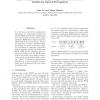Free Online Productivity Tools
i2Speak
i2Symbol
i2OCR
iTex2Img
iWeb2Print
iWeb2Shot
i2Type
iPdf2Split
iPdf2Merge
i2Bopomofo
i2Arabic
i2Style
i2Image
i2PDF
iLatex2Rtf
Sci2ools
NAACL
2003
2003
Implicit Trajectory Modeling through Gaussian Transition Models for Speech Recognition
It is well known that frame independence assumption is a fundamental limitation of current HMM based speech recognition systems. By treating each speech frame independently, HMMs fail to capture trajectory information in the acoustic signal. This paper introduces Gaussian Transition Models (GTM) to model trajectories implicitly. Comparing to alternative approaches, such as segment modeling and parallel path HMM, GTM has the advantage that it integrates seamlessly with the HMM framework; it can model a large number of trajectories and there is no need to define a topology a priori. Preliminary experiments on Switchboard, a large vocabulary conversational speech recognition task, have shown promising results. 1 Motivation Hidden Markov model (HMM) has been the dominant approach in automatic speech recognition for years. Several assumptions are made in HMMs, one of which is frame independence: all speech frames are conditionally independent given the hidden state sequence. This makes HM...
Related Content
| Added | 31 Oct 2010 |
| Updated | 31 Oct 2010 |
| Type | Conference |
| Year | 2003 |
| Where | NAACL |
| Authors | Hua Yu, Tanja Schultz |
Comments (0)

